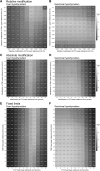Defining Gestational Thyroid Dysfunction Through Modified Nonpregnancy Reference Intervals: An Individual Participant Meta-analysis
- PMID: 39083675
- PMCID: PMC11479686
- DOI: 10.1210/clinem/dgae528
Defining Gestational Thyroid Dysfunction Through Modified Nonpregnancy Reference Intervals: An Individual Participant Meta-analysis
Abstract
Background: Establishing local trimester-specific reference intervals for gestational TSH and free T4 (FT4) is often not feasible, necessitating alternative strategies. We aimed to systematically quantify the diagnostic performance of standardized modifications of center-specific nonpregnancy reference intervals as compared to trimester-specific reference intervals.
Methods: We included prospective cohorts participating in the Consortium on Thyroid and Pregnancy. After relevant exclusions, reference intervals were calculated per cohort in thyroperoxidase antibody-negative women. Modifications to the nonpregnancy reference intervals included an absolute modification (per .1 mU/L TSH or 1 pmol/L free T4), relative modification (in steps of 5%) and fixed limits (upper TSH limit between 3.0 and 4.5 mU/L and lower FT4 limit 5-15 pmol/L). We compared (sub)clinical hypothyroidism prevalence, sensitivity, and positive predictive value (PPV) of these methodologies with population-based trimester-specific reference intervals.
Results: The final study population comprised 52 496 participants in 18 cohorts. Optimal modifications of standard reference intervals to diagnose gestational overt hypothyroidism were -5% for the upper limit of TSH and +5% for the lower limit of FT4 (sensitivity, .70, CI, 0.47-0.86; PPV, 0.64, CI, 0.54-0.74). For subclinical hypothyroidism, these were -20% for the upper limit of TSH and -15% for the lower limit of FT4 (sensitivity, 0.91; CI, 0.67-0.98; PPV, 0.71, CI, 0.58-0.80). Absolute and fixed modifications yielded similar results. CIs were wide, limiting generalizability.
Conclusion: We could not identify modifications of nonpregnancy TSH and FT4 reference intervals that would enable centers to adequately approximate trimester-specific reference intervals. Future efforts should be turned toward studying the meaningfulness of trimester-specific reference intervals and risk-based decision limits.
Keywords: pregnancy; reference values; thyroid function tests; thyroid gland; thyrotropin; thyroxine.
© The Author(s) 2024. Published by Oxford University Press on behalf of the Endocrine Society.
Figures



References
-
- Levie D, Korevaar TIM, Bath SC, et al. . Thyroid function in early pregnancy, child IQ, and autistic traits: a meta-analysis of individual participant data. J Clin Endocrinol Metab. 2018;103(8):2967‐2979. - PubMed
-
- Han Y, Gao X, Wang X, et al. . A systematic review and meta-analysis examining the risk of adverse pregnancy and neonatal outcomes in women with isolated hypothyroxinemia in pregnancy. Thyroid. 2023;33(5):603‐614. - PubMed
Publication types
MeSH terms
Substances
Grants and funding
LinkOut - more resources
Full Text Sources
Medical
Research Materials

